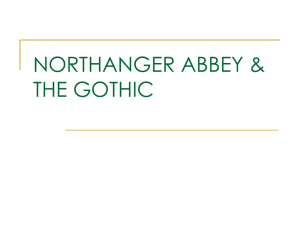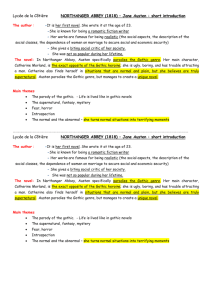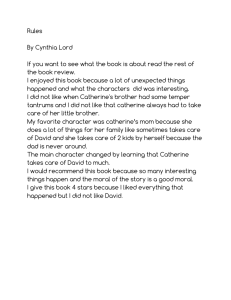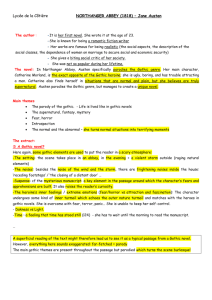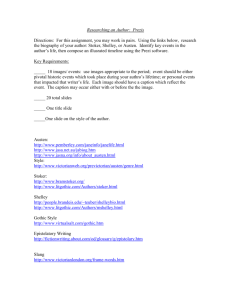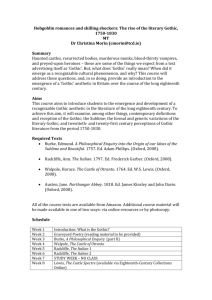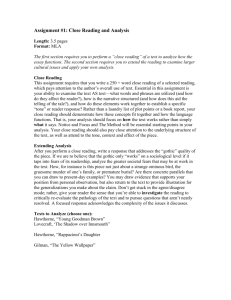Northanger Abbey - Stannersenglishmatters
advertisement
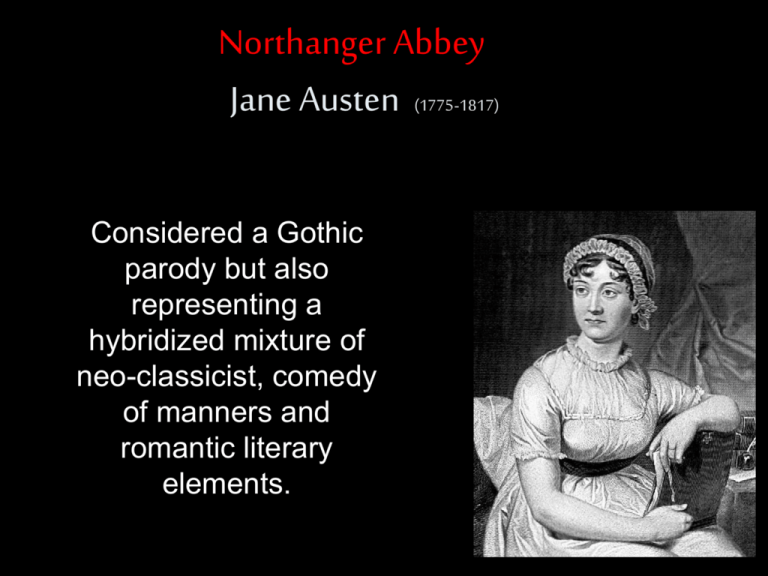
Northanger Abbey Jane Austen (1775-1817) Considered a Gothic parody but also representing a hybridized mixture of neo-classicist, comedy of manners and romantic literary elements. Gothic vs. Romantic Gothic Characteristics – Helpless victim against his torturer – Takes place in a cathedral or a haunted mansion – The novel gives a sense of fear, mystery and darkness Romantic Characteristics – – – – – Love of nature The supernatural Heroism Neo-classism clearness, elegance, symmetry Northanger Abbey: It is considered a romantic novel, but as the main character Catherine becomes more involved with her gothic novels the reader gets a sense of both gothic and romantic characteristics Fantasy vs. Reality Catherine imagines her stay at the abbey will be filled with mystery and she searches through chests and secret rooms in order to find clues or evidence Catherine compares her passion of reading gothic novels such as The Mysteries of Udolpho to the abbey – “Its long, damp passages, its narrow cells and ruined chapel, were to be within her daily reach, and she could not entirely subdue the hope of some traditional legends, some awful memorials of an injured and ill-fated nun” (132). Catherine Morland is described as being plain, and she doesn’t fit the characteristics of a heroine – “Catherine, for many years of her life, as plain as any. She had a thin awkward figure, a sallow skin without color, dark lank hair and strong features” (7). – “She never could learn or understand anything before she was taught; and sometimes not even then, for she was often inattentive and occasionally stupid” (8). What makes Catherine a heroine? She defies stereotypes of her time She keeps strong morals, despite peer pressure. She matures and grows as a character and as a person. Avid reader, Catherine, sees herself as a hero. “No one who had ever seen Catherine Morland in her infancy, would have supposed her born to be an heroine”(7), but she proves to be one anyways. ‘Northanger Abbey’ Criticism Reflects the commercialization of literature during the late 18th century – 18th century brings more public circulation of libraries – commercialization of literature and textual skimming, changes the way people read stories – Northanger Abbey a critique of materialistic society, narrator gives lens to view it – Literature: for self-improvement or social standard? Catherine is “frequently duped by the harsh world” Northanger Abbey conveys Austen’s theme of “the importance of the education of judgment” Nicola Cummins Gothic Parody ‘Too often the modern assumption is that all parody, like burlesque, must ridicule its object.’ Everett Zimmerman Austen uses parody, not to completely reject aspects of ‘sentimental’ fiction, but to also show an appreciation for some aspects. ‘Sentimental’ fiction is both mocked and valued throughout Northanger Abbey – it’s almost as if the discovery of one’s self (in Catherine’s case) is the means through which Austen suggests a notion of balance within fiction. Parody acts as a device to force the reader to search for meaning and purpose within the novel. ‘The narrator has made it difficult for Catherine not to be recognised as a potential heroine, but because the language is understated and Catherine’s ignorance is emphasized...the reader is forced to sort out the hidden heroic qualities...’ Gothic Parody continued: •mocks and uses the forms and conventions of the Gothic novel. •parodic discourse so that reader are kept off balance •Austen positions two kinds of readers and two kinds of texts; •The naïve reader or romantic who would expect a heroine to be an orphan and to engage in ‘the more heroic enjoyments of infancy’. This reader is to find that NA disrupts or disorientates their expectations • More sophisticated reader who rejects romance and knows a parody when he sees one . •Readers are not only a partner in the narrative but an opponent who struggles with the narrator for control of the text •The relationship between the characters and the author are a tool for parody. Austen emphasises Isabella as being superficial. The contrasts between characters parodies the excess of Romantic tenets. •Burlesque = intention of humour – treats lofty material humorously or pretends something ordinary is significant & dignified Author’s Purpose? Reading novels causes foolish imagination in the reader and leads to all sorts of dangers Reading novels is harmless as long as the reader doesn’t mistake them for real life Its not necessary to find danger in novels, there’s plenty in real life Links to Romanticism ? The Romantic Age brought a more daring, individual, and imaginative approach to literature and life. Writers valued the individual rather than society and optimistically believed in the possibilities of progress and social / human reform. To what extent does ‘Northanger Abbey’ support or subvert such Romanticist values and attitudes? Valuing the imagination, individual and idealism Search for meaning through relationships with the natural world and wider social context Examination or affirmation of the power of the imagination to inform, illuminate and transform human experience Experimentation with ideas and forms which may reflect or challenge ways of thinking Henry Tilney Henry as the hero/mentor - embodiment of the narrator’s values who will rid the heroine of her romantic, girlish fantasies Catherine senses that he is mocking conventions but does not know “whether she might venture to laugh”. Just as Catherine doesn’t know how to respond to mockery the reader is unsure of the intended effect of the narrator As Catherine tries to make sense of Isabella’s inconsistencies, she turns to Henry to provide an authoritative interpretations –– a parental narrator trying to protect her’ Against all her own instincts Catherine is convinced his speech ‘carried her captive’ because ‘Henry Tilney must know best’. Throughout NA ‘Tilney chooses whatever rhetoric suits him– parodic, critical, measured, ‘Austen may be providing polarities – explicit commendation of novels vs implied criticism in parody – to alert the reader to the dangers of generalisation’ Narrative Techniques Dialogue: direct, indirect, interior Dramatic irony = situation is apparent to the reader, but not to the character (laundry list) Verbal irony = words used in an opposite manner to their literal meaning (‘the delicacy, discretion, originality of thought, and literary taste which marked the reasonableness of that attachment’). Use of negatives: ‘without’ ‘never’ ‘instead of’ Socratic irony = adopts a character’s viewpoint to ridicule them – shows us her characters foibles (dialogue of Isabella, Thorpe & Mrs Allen reported second hand as so tedious) ‘To control the reader response, direct comment on novels is used by both narrator and characters.’ There is an underlying suggestion of balance; Austen doesn’t completely reject the Romantic precepts, regarding the gothic in literature, but rather ‘...her imagination...using it to discern what aspects of human nature lie beyond convention.’
